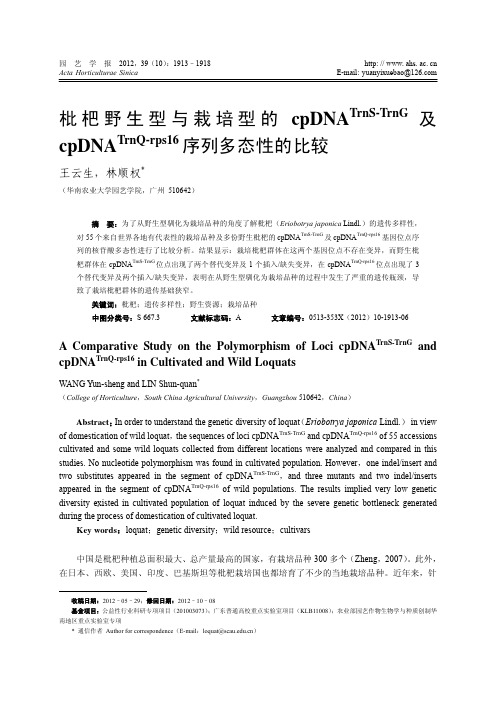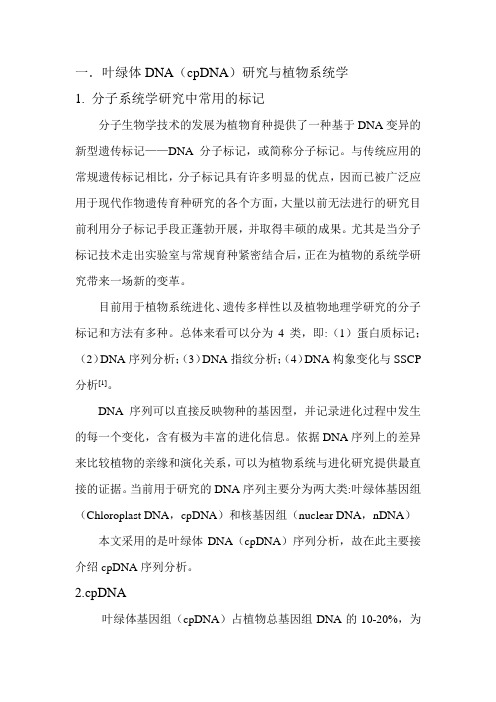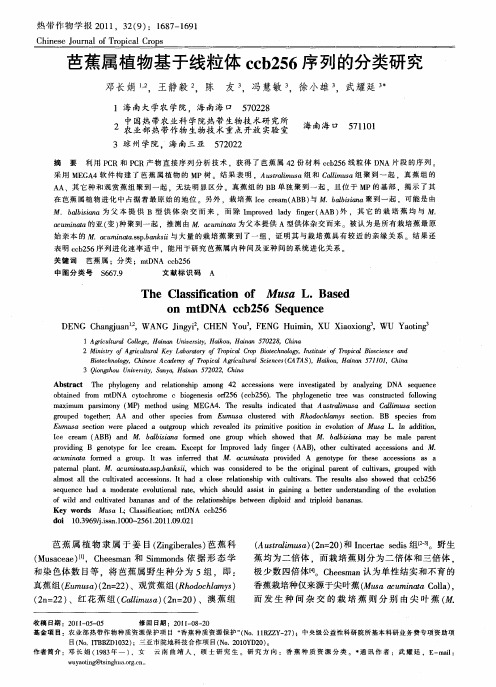芭蕉属植物cpDNAL16序列限制性片段长度多态性研究
- 格式:pdf
- 大小:427.65 KB
- 文档页数:8


云南辣木资源遗传多样性的AFLP分析郑硕理;邵建辉;张敬丽;高熹;田洋;张广辉;杨生超;马春花【摘要】为了揭示云南栽培辣木的遗传多样性和亲缘关系,为国内辣木种质资源的进一步有效开发与利用提供依据,采用AFLP技术对27份云南栽培辣木材料进行了遗传多样性分析,筛选得到9对条带清晰、多态性高的引物,共扩增出946条条带;其中,多态性条带913条,平均每对引物扩增条带105条,多态性条带101条,多态性位点频率为96.19%,表明云南栽培辣木具有较为丰富的遗传多态性.27份材料间遗传相似系数变化范围为0.657 5~0.838 3.UPGMA聚类结果表明:27份材料可分为6类,来自同一栽培区域的材料并没有聚在一起,具有相同性状的材料也没有聚在一起,表明栽培辣木种群内遗传分化较大,遗传背景复杂,相关性状和遗传的关系仍需进一步研究.【期刊名称】《云南农业大学学报》【年(卷),期】2016(031)005【总页数】6页(P850-855)【关键词】辣木;AFLP;遗传多样性【作者】郑硕理;邵建辉;张敬丽;高熹;田洋;张广辉;杨生超;马春花【作者单位】云南农业大学,云南省优势中药材规范化种植工程研究中心,云南昆明650201;云南农业大学园林园艺学院,云南昆明650201;云南农业大学云南辣木研究所,云南昆明650201;云南农业大学,云南省优势中药材规范化种植工程研究中心,云南昆明650201;云南农业大学园林园艺学院,云南昆明650201;云南农业大学云南辣木研究所,云南昆明650201;云南农业大学云南辣木研究所,云南昆明650201;云南农业大学,云南省优势中药材规范化种植工程研究中心,云南昆明650201;云南农业大学,云南省优势中药材规范化种植工程研究中心,云南昆明650201;云南农业大学,云南省优势中药材规范化种植工程研究中心,云南昆明650201;云南农业大学园林园艺学院,云南昆明650201;云南农业大学云南辣木研究所,云南昆明650201【正文语种】中文【中图分类】S794辣木(Moringa oleifera Lam.)为辣木科辣木属植物,原产于印度,又称为鼓槌树,是多年生热带落叶乔木(若一些地区冬季温度高,水肥条件好,则表现为常绿)。

园艺学报 2012,39(10):1913–1918 http: // www. ahs. ac. cn Acta Horticulturae Sinica E-mail: yuanyixuebao@ 枇杷野生型与栽培型的cpDNA TrnS-TrnG及cpDNA TrnQ-rps16序列多态性的比较王云生,林顺权*(华南农业大学园艺学院,广州 510642)摘 要:为了从野生型驯化为栽培品种的角度了解枇杷(Eriobotrya japonica Lindl.)的遗传多样性,对55个来自世界各地有代表性的栽培品种及多份野生枇杷的cpDNA TrnS-TrnG及cpDNA TrnQ-rps16基因位点序列的核苷酸多态性进行了比较分析。
结果显示:栽培枇杷群体在这两个基因位点不存在变异,而野生枇杷群体在cpDNA TrnS-TrnG位点出现了两个替代变异及1个插入/缺失变异,在cpDNA TrnQ-rps16位点出现了3个替代变异及两个插入/缺失变异,表明在从野生型驯化为栽培品种的过程中发生了严重的遗传瓶颈,导致了栽培枇杷群体的遗传基础狭窄。
关键词:枇杷;遗传多样性;野生资源;栽培品种中图分类号:S 667.3 文献标志码:A 文章编号:0513-353X(2012)10-1913-06A Comparative Study on the Polymorphism of Loci cpDNA TrnS-TrnG and cpDNA TrnQ-rps16 in Cultivated and Wild LoquatsWANG Yun-sheng and LIN Shun-quan*(College of Horticulture,South China Agricultural University,Guangzhou 510642,China)Abstract:In order to understand the genetic diversity of loquat(Eriobotrya japonica Lindl.) in view of domestication of wild loquat,the sequences of loci cpDNA TrnS-TrnG and cpDNA TrnQ-rps16 of 55 accessions cultivated and some wild loquats collected from different locations were analyzed and compared in this studies. No nucleotide polymorphism was found in cultivated population. However,one indel/insert and two substitutes appeared in the segment of cpDNA TrnS-TrnG,and three mutants and two indel/inserts appeared in the segment of cpDNA TrnQ-rps16 of wild populations. The results implied very low genetic diversity existed in cultivated population of loquat induced by the severe genetic bottleneck generated during the process of domestication of cultivated loquat.Key words:loquat;genetic diversity;wild resource;cultivars中国是枇杷种植总面积最大、总产量最高的国家,有栽培品种300多个(Zheng,2007)。

一.叶绿体DNA(cpDNA)研究与植物系统学1. 分子系统学研究中常用的标记分子生物学技术的发展为植物育种提供了一种基于DNA变异的新型遗传标记——DNA分子标记,或简称分子标记。
与传统应用的常规遗传标记相比,分子标记具有许多明显的优点,因而已被广泛应用于现代作物遗传育种研究的各个方面,大量以前无法进行的研究目前利用分子标记手段正蓬勃开展,并取得丰硕的成果。
尤其是当分子标记技术走出实验室与常规育种紧密结合后,正在为植物的系统学研究带来一场新的变革。
目前用于植物系统进化、遗传多样性以及植物地理学研究的分子标记和方法有多种。
总体来看可以分为4类,即:(1)蛋白质标记;(2)DNA序列分析;(3)DNA指纹分析;(4)DNA构象变化与SSCP 分析[1]。
DNA序列可以直接反映物种的基因型,并记录进化过程中发生的每一个变化,含有极为丰富的进化信息。
依据DNA序列上的差异来比较植物的亲缘和演化关系,可以为植物系统与进化研究提供最直接的证据。
当前用于研究的DNA序列主要分为两大类:叶绿体基因组(Chloroplast DNA,cpDNA)和核基因组(nuclear DNA,nDNA)本文采用的是叶绿体DNA(cpDNA)序列分析,故在此主要接介绍cpDNA序列分析。
2.cpDNA叶绿体基因组(cpDNA)占植物总基因组DNA的10-20%,为双链闭环结构,一般为120-220kb(多在120-160kb之间),被2个长约22-25kb的反向重复序列(IR)分成大拷贝区(LSc)和小两个单拷贝区(SSC)。
在过去二十年里,.植物系统学家们依据叶绿体DNA序列进行了大量的系统发育分析[2]。
因为cpDNA具有一下优势:第一,叶绿体基因组在植物细胞中虽为多拷贝,但其序列都是一样的,便于操作[3];第二,叶绿体基因组是单亲遗传的,不存在核基因中出现的基因重组等问题;第三,由于叶绿体基因组序列的保守性,扩增叶绿体片段的引物是通用的;第四,非编码区的叶绿体DNA具有更多的信息位点,且测序的工作量不大,更适合于低等级类群的系统发育研究。

中国农业大学学报 2009,14(4):1-9Journal o f China A g ricultur al U niv ersity末端限制性片段长度多态性技术(T -RFLP)在微生物群体分析上的应用与技术优化李献梅 王小芬 崔宗均*(中国农业大学农学与生物技术学院/中国农业大学生物质工程中心,北京100193)摘 要 末端限制性片段长度多态性技术(T-RFL P)是以荧光标记引物P CR 为基础,根据末端限制性片段长度区分出微生物群体组成的一种微生物群体图谱法。
本文综述了该方法在群体微生物分析上的应用及DN A 提取、PCR 扩增、酶切和数据分析等步骤的技巧与优化,总结了科学应用该技术的要求以及和多重PCR 、gy r B 基因等相结合的观点。
关键词 T -RF LP ;微生物群体;图谱分析;PCR;克隆中图分类号 Q 936 文章编号 1007-4333(2009)04-0001-09 文献标志码 A收稿日期:2008-10-27基金项目:国家/十一五0科技支撑计划(2006BAD07A 01;2006BA D25B04)第一作者:李献梅,博士研究生,E -mail:staro fchina@g 通讯作者:崔宗均,教授,主要从事生物质资源利用与微生物生态研究,E -mail:acuizj@Applications and optimizations of T -RFLP in fingerprintingenvironm ental microbial populationsLI Xian -mei,WANG Xiao -fen ,CUI Zong -jun *(College of Agronomy and Biotechnology/Center of Biomas s Engineeri ng,Chi na Agricul tural U nivers i ty,Bei jing,100193,China)Abstract Terminal re stric tio n fra gment leng th polymorphis m (T -RFLP)is one o f micro bia l popula tio n fing erprinting me tho ds tha t is ba sed o n labele d primers -PCR to ide ntify microbial co mposition a ccording to diffe re nt terminal re stric tio n frag me nt leng ths.The applic ations and te chnica l o ptimizations we re o ve rv iew ed o f T -RFLP thro ugh the pro cedures of DNA preparation,PCR,enzyme dig estion and da ta analysis.The sc ientific applic ation re quire me nts and new view s of combination with multiple -PCR o r g yr B g e ne we re dra wn.Key words T -RFLP;microbial po pulation;fing erprinting ana lysis;PCR;clone libra ry当前环境微生物组成及生态研究已经成为微生物领域的一大热点[1]。

基于 cpDNA trnL-F 序列的胡黄连保护遗传学研究李国栋;尹子丽;刘小莉【摘要】Neopicrorhiza scrophulariiflora (Scrophulariaceae), a monotypic genus perennial species, is endemic to the Eastern Himalayas and the Hengduan Mountains region. It only distributes in Yunnan and Tibet in China, ranging from 3 600 m to 4 200 m in elevation. The long and creep rhizomes (Rhizoma Neopicrorhizae) are of high medicinal value and dysentery by traditional Chinese and Tibetan medicine. Mainly because of large-scale acquisitions activity, natural popu-lations of this species have suffered rapid declines and now it is classified as an endangered species under second catego-ry of key protected wild plants in China. In order to protect the decreasing natural genetic resources of N. scrophulariiflo-ra, in this study, the chloroplast DNA (cpDNA) trnL-F noncoding sequence was used to estimate the genetic diversity and genetic structure and the evolutionary significant units (ESU) were proposed. A total of 91 individuals of N. scrophu-lariiflora were collected from seven populations, covering almost all areas of its distribution ranges. Of these seven popu-lations, four were from Yunnan Province and three populations were from Tibet. The statistical results showed that the haplotype sequences length varied from 871 bp to 876 bp. A total of five haplotypes were detected based on trnL-F nucle-otide variation. Yunnan contains three haplotypes and Tibet contains two. However, none of common haplotypes were shared between the populations from Yunnan and Tibet. A normal lowlevel of genetic diversity (Hd = 0.434 19) and nucleotide diversity (Dij = 0.004 66) were identified at the species level. A high level of genetic differentiation (0.96) among populations was revealed. AMOVA results from chloroplast data indicated that 0.78% of the genetic variation was partitioned within population, 60.97% among populations within groups, and 38.25% among groups under the condition that N. scrophulariiflora was divided into two groups including Yunnan and Tibet. The U-statistic test for phylogeographi-cal structure showed that NST was significantly higher than GST(NST >GST , P < 0.01), which suggested a distinctly phylo-geographical pattern The gene flow (Nm) was extremely low with only 0.04. The higher NST than GST(P<0.01) suggested a distinctly phylogeographical pattern. Conjoint Fst (0.864 520), gene flow, GST and AMOVA results all indicated a sig-nificant high level of genetic differentiation among populations, which could be a consequence of the limited gene flow caused by geographic isolation among populations. Phylogenetic analysis of the haplotypes sequences identified three ten-tative clades (Ⅰ,Ⅱand Ⅲ) according to Majority-rule consensus tree. All of which had distinct geographic range: CladeⅠcomprised four populations (CZ, YZ, SN, BM) which were located at the Hengduan Mountains region; CladeⅡcom-prised one population (BMI), which was located at the Eastern Himalayas region; and Clade Ⅲ comprised two popula-tions (DR, NLM) located at the Central Himalayas region. Based on the phylogenetic analyses and uniqueness of the populations, three evolutionary significant units (ESU) were identified and conservation strategies were discussed forthis endangered species. Baimaxueshan and Cizhong, Bomi, Nielamu and Dingri populations respectively concluded in the three evolutionary significant units and the five populations all contained special haplotypes. Based on these findings, all the populations should be protected. However, in consideration of the actual distribution of every population, Baimax-ueshan population from Yunnan and Bomi population from Tibet shouldbe given priority for conservation and in situ con-servation should be the ideal implement.%胡黄连为特产中国-喜马拉雅特有高山植物,作为常用中、藏药材,受到灭绝性采挖,作为濒危和二级保护植物亟待科学的保护。
芭蕉属植物基于线粒体ccb256序列的分类研究邓长娟;王静毅;陈友;冯慧敏;徐小雄;武耀廷【期刊名称】《热带作物学报》【年(卷),期】2011(032)009【摘要】The phylogeny and relationship among 42 accessions were investigated by analyzing DNA sequence obtained from mtDNA cytochrome c biogenesis orf256 (ccb256). The phylogenetic tree was constructed following maximum parsimony (MP) method using MEGA4. The results indicated that Australimusa and Callimusa section grouped together; AA and other species from Eumusa clustered with Rhodochlamys section. BB species from Eumusa section were placed a outgroup which revealed its primitive position in evolution of Musa L. In addition, Ice cream (ABB) and M. Balbisiana formed one group which showed that M. Balbisiana may be male parent providing B genotype for Ice cream. Except for Improved lady finger (AAB), other cultivated accessions and M. Acuminata formed a group. It was inferred that M. Acuminata provided A genotype for these accessions as a paternal plant. M.Acumlnata.ssp.banksii, which was considered to be the original parent of cultivars, grouped with almost all the cultivated accessions. It had a close relationship with cultivars. The results also showed that ccb256 sequence had a moderate evolutional rate, which should assist in gaining a better understanding of the evolution of wild and cultivated bananas and of therelationships between diploid and triploid bananas.%利用PCR和PCR产物直接序列分析技术,获得了芭蕉属42份材料ccb256线粒体DNA片段的序列.采用MEGA4软件构建了芭蕉属植物的MP树.结果表明,Australimusa组和Callimusa 组聚到一起,真蕉组的AA、其它种和观赏蕉组聚到一起,无法明显区分.真蕉组的BB 单独聚到一起,且位于MP的基部,揭示了其在芭蕉属植物进化中占据着最原始的地位.另外,栽培蕉Ice cream(ABB)与M.balbisiana聚到一起,可能是由M.balbisiana为父本提供B型供体杂交而来,而除Improved lady finger(AAB)外,其它的栽培蕉均与M.acuminata的亚(变)种聚到一起,推测由M.acuminata为父本提供A型供体杂交而来.被认为是所有栽培蕉最原始亲本的M.acuminata.ssp.banksii与大量的栽培蕉聚到了一组,证明其与栽培蕉具有较近的亲缘关系.结果还表明ccb256序列进化速率适中,能用于研究芭蕉属内种间及亚种间的系统进化关系.【总页数】5页(P1687-1691)【作者】邓长娟;王静毅;陈友;冯慧敏;徐小雄;武耀廷【作者单位】海南大学农学院,海南海口 570228;中国热带农业科学院热带生物技术研究所海南海口 571101;农业部热带作物生物技术重点开放实验室;中国热带农业科学院热带生物技术研究所海南海口 571101;农业部热带作物生物技术重点开放实验室;琼州学院,海南三亚572022;琼州学院,海南三亚572022;琼州学院,海南三亚572022;琼州学院,海南三亚572022【正文语种】中文【中图分类】S667.9【相关文献】1.基于多变量形态度量学和线粒体Cytb序列的鲈属鱼类分类探讨 [J], 海萨;李家乐;冯建彬;木拉提2.芭蕉属植物cpDNAL16序列限制性片段长度多态性研究 [J], 李博;陈雪婷;姚益娟;冯慧敏;武耀廷3.基于线粒体COⅠ基因序列探讨臂尾轮属的系统发生和几种轮虫的分类地位 [J], 程双怀;席贻龙;项贤领;胡好远4.基于线粒体DNA控制区序列变异探讨黑龙江和图们江细鳞鲑属鱼类的分类地位[J], 马波;姜作发;霍堂斌5.基于ITS2序列的清风藤属药用植物分类鉴定研究 [J], 严福林;温迪;任得强;王波;徐文芬;孙庆文;魏升华因版权原因,仅展示原文概要,查看原文内容请购买。